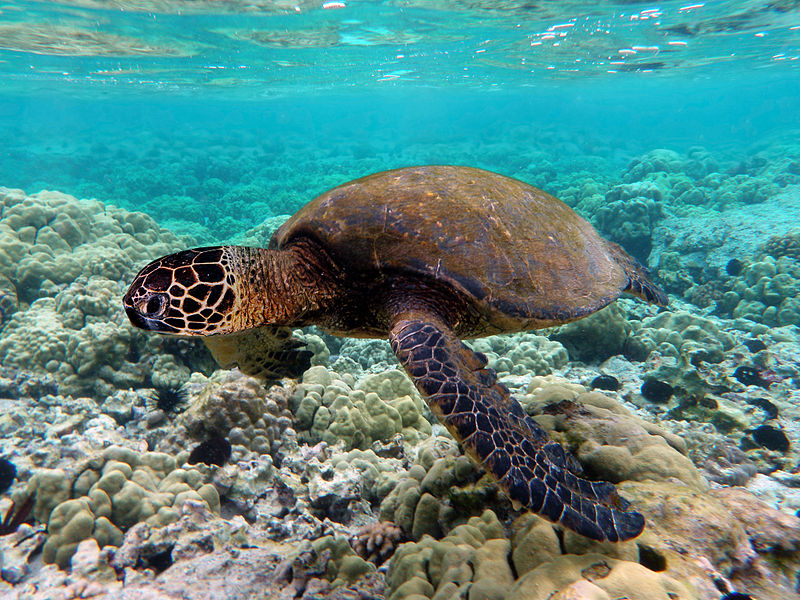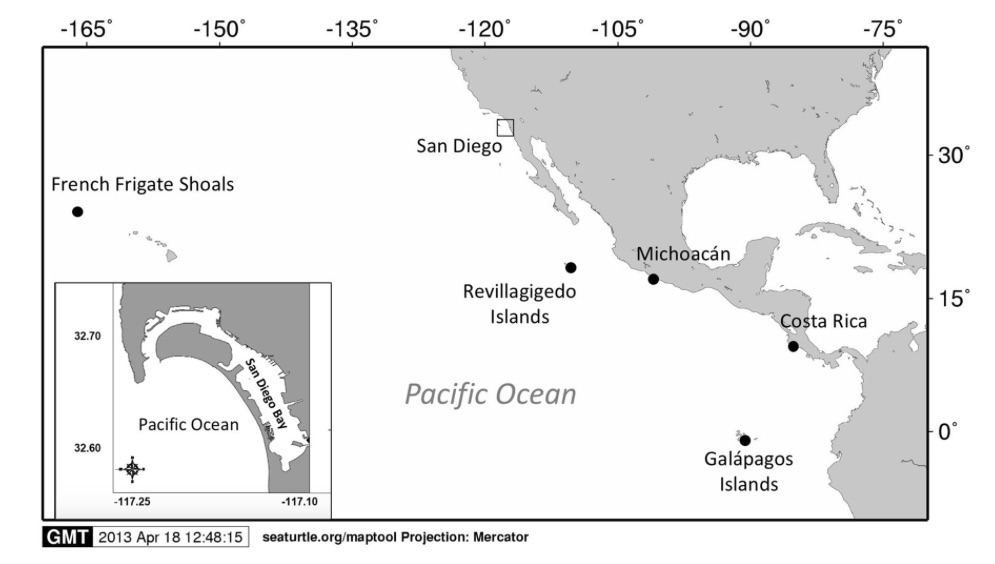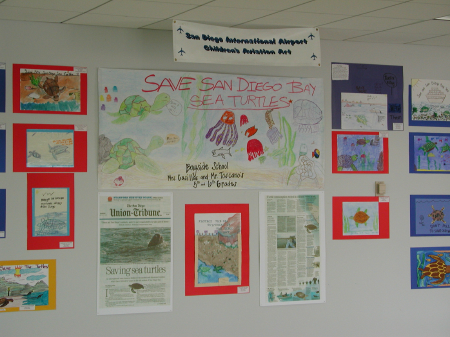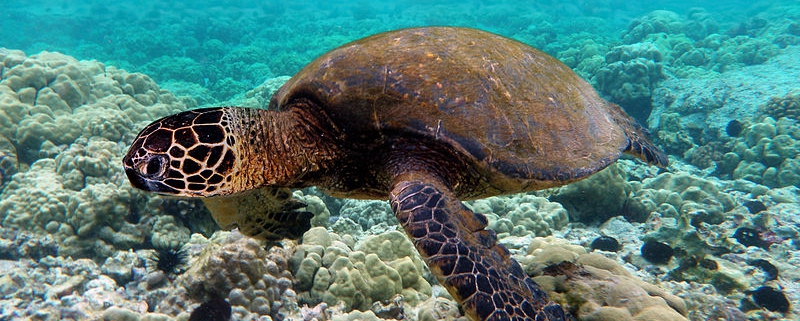A Multi-Faceted and Comprehensive Approach to Understanding San Diego Bay’s Green Turtle Populations and their Origin
By: Casey Dresbach, SRC Intern
Green turtles (Chelonia mydas) have called the South San Diego Bay home since the 1850s (National Oceanic and Atmospheric Administration (NOAA) Fisheries , 2014). Their origin however remains a mystery. There are beliefs that commercial fishermen of the mid 17th century harvested the species in Mexican waters and brought them back to San Diego Bay (National Oceanic and Atmospheric Administration (NOAA) Fisheries , 2014). Yet upon transit, many believe the turtles may have escaped and perhaps justify the presence of Chelonia mydas population in San Diego Bay today. San Diego Bay, California has been documented as one of the northern-most foraging areas for green turtles in the eastern Pacific (Figure 2). (Dutton, LeRoux, LaCasella, Seminoff, Eguchi, & Dutton, 2018)

Figure 1. Green Sea Turtle. (Caption: Green Sea Turtle, Chelonia mydas.) (Wikimedia Commons, 2010)

Figure 2. Green Sea Turtle Nesting Sites and Foraging Site. (Caption: Nesting sites (circles) of Green Sea Turtle, Chelonia mydas as well as foraging site in the northern part of San Diego Bay.) (Dutton, LeRoux, LaCasella, Seminoff, Eguchi, & Dutton, 2018)
Turtles are marine reptiles whose life history includes a terrestrial component for reproduction, where females lay their eggs on tropical or sub-tropical beaches (Miller 1997). Green turtles in the eastern Pacific Ocean continue to face threats posed by human imprint. Some of these include habitat destruction, incidental capture in commercial fisheries, and often illegal harvesting (National Oceanic and Atmospheric Administration (NOAA) Fisheries , 2014). Green turtles are listed on the IUCN as an endangered species (Dutton, LeRoux, LaCasella, Seminoff, Eguchi, & Dutton, 2018). Hence, many recent studies aim to understand their geographical patterns, how and why they end up in certain regions, to ultimately engage in comprehensive measures of conservation. The greatest threat posed to this species among several other marine and terrestrial animals is in fact the contribution of industrialization. In a 2010 study by (Eguchi, Tomoharu & Seminoff, Jeffrey & A. LeRoux, Robin & H. Dutton, Peter & L. Dutton, Donna), the abundance and survival rates of green turtles in an urban environment was examined. The coexistence of humans and an endangered species was analyzed specifically because of the turtles’ proximity to warm effluent from a power plant nearby. With 99 capture sessions between 1990-2009, 96 turtles were caught. Researchers constructed design-mark-recapture models to estimate abundance and recapture rates. This work provided both the first survival rate and abundance estimates for a green turtle foraging population in industrialized San Diego Bay (Eguchi, Tomoharu et. al 2010).
In 2018, a study was conducted to reveal the origin of the green turtle population in San Diego Bay. In aiming to understand population structure and migration patterns, researchers used a combination of genetics and satellite telemetry to identify the nesting stock origin of Chelonia mydas foraging in San Diego Bay (Dutton, LeRoux, LaCasella, Seminoff, Eguchi, & Dutton, 2018). They examined the stock origin of green turtle foraging aggregation in San Diego using segregated pieces of mtDNA (770 bp) from 121 green turtles captured in San Diego and then compared them to nesting populations across the greater Pacific. Mixed stock analysis was conducted to look at where all these green turtles had originated. This provided indication that the San Diego Bay foraging population originates from eastern Pacific nesting sites, primarily the Revillagigedo Archipelago and the coast of Michoacán, Mexico (Dutton, LeRoux, LaCasella, Seminoff, Eguchi, & Dutton, 2018). Further evaluation of current life history hypotheses was enhanced with the satellite tagging of 3 female green turtles in the San Diego foraging ground (FG) to track migration patterns. After 364 days, one had nested at Socorro Island in Revillagigedo and returned to San Diego Bay and another was tracked nesting at Tres Marias Islands near the Mexican mainland coast. Of critical importance was that all three returned back to San Diego Bay. These findings locate green turtle populations from Revillagigedo Islands and Michoacán as well as the Tres Marias Islands. Their findings supported the mixed stock analysis indication of where the San Diego foraging population originates. With more insight and accumulation of data such as these, heightened conservation efforts in areas such as the Tres Marias Islands, Revillagigedo Islands, and Michoacán can be done.
Further research needs to be conducted to better understand the migration patterns and selection of FG in lieu of the threats posed by the human imprint. Despite scientific efforts, the general public can have a major influence on further conservation of the species. Public outreach and engagement is a multifaceted tool that informs those both inside and outside of scientific communities and often simultaneously establishes a personal connection to an area of concern. Pairing an unfamiliar subject matter with something recognizable will not only incite curiosity but also serve better when trying to relay conservation messages to a wider audience. For example, when a child is introduced to a topic of subject matter in a way that is familiar to them through art or a game, he or she is more likely to engage (See Figure 3). With that personalization comes a greater likelihood that an individual or set of individuals will pursue that newfound connection further. Especially when the matter, such as polluting by the coast, will affect their and those of generations to come. With urbanization on the rise and industrialization seeping further into coastal habitats marine and terrestrial life are suffering at that expense. Disseminating knowledge about how the human imprint is and will continue to deteriorate ecosystems worldwide is crucial to inciting behavioral changes.

Figure 3. Sea Turtle outreach at the San Diego International Airport JPEG aligned in text to the left. (Caption: Public outreach and engagement is crucial to bridging the gap between the informed and the uninformed. The engagement of students is critically important as they become the next generation and future voices of change).
Work Cited:
Dutton, P. H., LeRoux, R. A., LaCasella, E. L., Seminoff, J. A., Eguchi, T., & Dutton, D. L. (2018, November 8). Genetic analysis and satellite tracking reveal origin of the green turtles in San Diego Bay . Marine Biology .
Eguchi, Tomoharu & Seminoff, Jeffrey & A. LeRoux, Robin & H. Dutton, Peter & L. Dutton, Donna. (2010). Abundance and survival rates of green turtles in an urban environment: Coexistence of humans and an endangered species. Marine Biology. 157. 1869-1877. 10.1007/s00227-010-1458-9.
Miller JD (1997) Reproduction in sea turtles. In: Musick JA, Lutz PL (eds) Biology of sea turtles. CRC Press, Boca Raton, pp. 51–82
National Oceanic and Atmospheric Administration (NOAA) Fisheries . (2014, December 24). Green Sea Turtle Research at San Diego Bay. Retrieved from NOAA Fisheries : https://swfsc.noaa.gov/textblock.aspx?Division=PRD&ParentMenuId=212&id=10134
NOAA. (n.d.). San Diego Bay Sea Turtles. (P. Dutton, Producer) Retrieved from National Oceanic and Atmospheric Administration (NOAA) Fisheries: https://swfsc.noaa.gov/textblock.aspx?Division=PRD&ParentMenuId=212&id=4378
Senko J, López-Castro MC, Koch V, Nichols WC (2010) Immature East Pacific green turtles (Chelonia mydas) use multiple foraging areas off the Pacific coast of Baja California Sur, Mexico: first evidence from mark-recapture data. Pac Sci 64 (1):125–130. https://doi.org/10.2984/64.1.125
Wikimedia Commons. (2010, May 10). Green turtle swimming over coral reefs in Kona. Retrieved from Wikimedia Commons: https://commons.wikimedia.org/wiki/File:Green_turtle_swimming_over_coral_reefs_in_Kona.jpg



